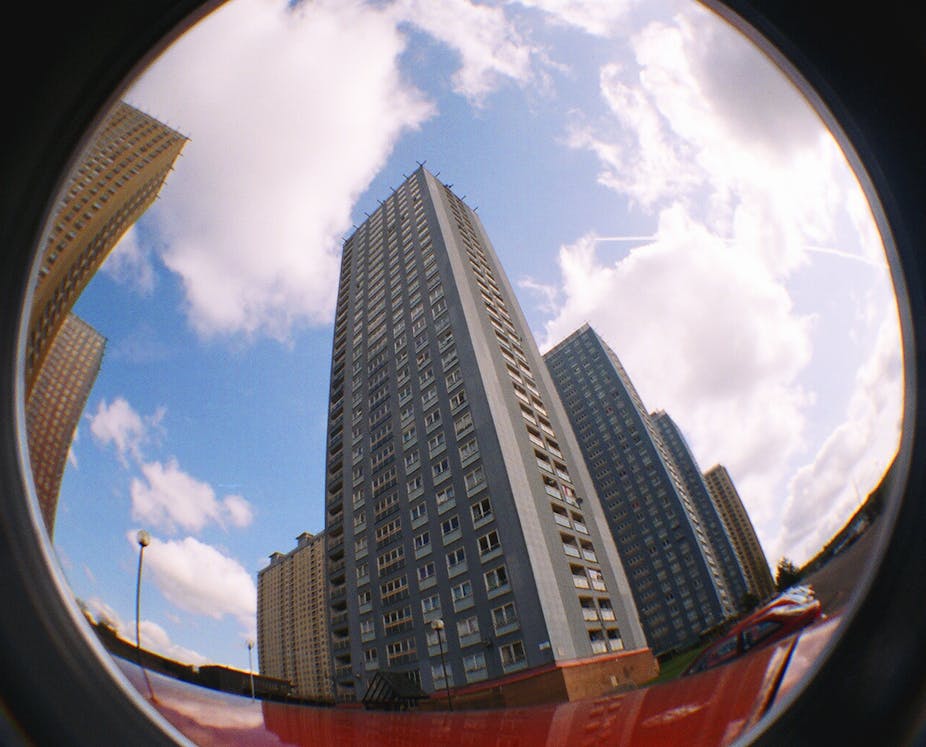Should we be celebrating the Commonwealth Games organisers’ decision not to demolish Glasgow’s iconic Red Road Flats as part of the opening ceremony, where the live footage was to be beamed on huge screens?
In the words of Gordon Matheson, leader of the Labour-controlled Glasgow City Council, this was to be “symbolic of a changing Glasgow”. But this sense of a bright future for the city as a legacy of the games was a long way from how it was seen by critics.
Within days, the decision had attracted considerable opposition from activists, artists and politicians. A petition attracted many thousands of signatures as the story became the lead item on news bulletins. Many will be wondering why it produced this reaction. I can certainly provide a few pointers.
In the post-1945 era, Glasgow constructed greater numbers of public sector high rises than any other city in Western Europe. This was an attempt to address the worst slums in the UK.
Together with a massive programme of low-rise housing estate development across the city, contained primarily on the outer-edges in Castlemilk, Drumchapel, Easterhouse and Pollok, by the 1970s Glasgow Corporation had become the largest public sector landlord in Western Europe with over 185,000 properties on its books.
The Red Road development in the north east, which opened in 1971, was not in any of these four areas. But it rapidly became the best known high-rise estate in the city.
Good views, draughty windows
The eight towers, ranging from 28 to 31 storeys high, housed almost 5000 people. At almost 300 feet, the views from the upper floors extended to the mountains of Argyll to the west, Stirlingshire to the north and almost to Edinburgh in the east.
For many new tenants, the new developments represented a vast improvement on their previous living conditions. They had running hot and cold water, inside bathrooms and separate kitchens.
Yet there were soon complaints from tenants that the flats were draughty and difficult to heat. They became not a hallmark of Glasgow’s advance in public sector housing design but a symbol of poor construction. By the end of the 20th century they had gained a reputation as unattractive places to live, and many flats were vacant for a considerable time.
On one level, the demolition plan reflects the longstanding argument that the flats like these were a social and economic blunder. But there is a deeper level to the symbolism. It tells a wide audience that it is waste of time and money to provide council housing for working-class people because it always ends up in failure.
Blame the tenants
Who is responsible for this failure? There is no mention of the architects, the engineers or the politicians. Nobody explicitly says it is the tenants’ fault, but the implication hangs in the air all the same.
What the escaped demolition actually reflects is the attempts by UK governments since the late 1970s to ensure that social housing is a residual category fit only for people with multiple and intractable problems: the chronically poor, drug addicts and alcoholics, the mentally ill, the homeless, refugees and asylum seekers.
Look no further than the plan for the block that would have remained after the five that would have been demolished in the games ceremony had gone: it is intended to accommodate refugees, again giving the strong impression that only people “of that kind” are fit to live there.
The plan also symbolised the destruction of the idea that state housing provision has a crucial role to play in meeting housing needs today – needs that are acute across Glasgow and much of the UK.
It is a symbol of the present government’s blatant attempt to destroy the whole idea of council housing as a concept belonging to a bygone age. This is implicitly an attack on council tenants and on the idea of council tenants.
Blow up working class history too
It is also part of the marginalisation of a particular working class history. There is another housing history in Glasgow which the elites would rather forget.
The city did more than any other in Britain to ensure the provision of council housing for the working class. The protracted struggles of Clydesiders over rents and housing issues, particularly the Glasgow rent strike of 1915, paved the way for state housing provision as a norm. The 1919 Housing & Town Planning Act was a direct result, and established the principle of the state’s provision of such housing.
These are the struggles worth celebrating, especially when greedy private landlords are also too prevalent today, contributing enormously to the country’s acute housing problems. The planners might have bowed to public opinion by deciding to scrap the demolition plan during the opening ceremony. But that’s about all that has changed.
A step in the right direction it might be, but a much more important goal to fight for is the launch of a new era of quality and affordable public sector housing for rent, under the control of democratically elected politicians. This does not mean a return to some rosy past but of the recognition that the provision of housing for all is the mark of a civilised society.
The Scottish government has already abolished the right to buy for new tenants of social housing and embarked on a small but important programme of social housing construction is of course to be welcomed.
As Scotland looks ahead to a future that may involve full independence, the mark of the good Scottish society will be to end housing problems for once and for all. That would be a legacy worth celebrating, would it not?

